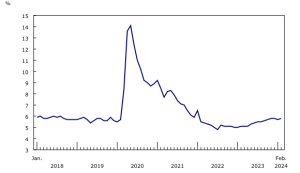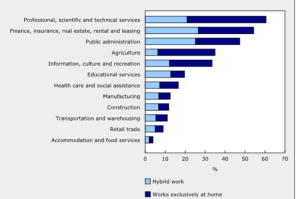
Unemployment rate increases to 5.8% in February, holding relatively steady since November
OTTAWA – Employment in Canada rose by 41,000 (+0.2%) in February, following a similar-sized increase in January (+37,000). In February, employment growth was driven by an increase in full-time work (+71,000; +0.4%). On a year-over-year basis, full-time work was up by 260,000 (+1.6%) in February, while part-time work was up by 108,000 (+3.0%).
Employment increased by 38,000 (+1.5%) among self-employed workers in February 2024, the first monthly increase since August 2023. There was little change in the number of public and private sector employees in the month. From February 2023 to February 2024, employment grew at a faster pace for public sector employees (+197,000; +4.7%) than for private sector employees (+160,000; +1.2%), while self-employment was little changed over the period (+11,000; +0.4%).
Unemployment Rate Increases in February
The unemployment rate increased 0.1 percentage points to 5.8% in February, offsetting the decline recorded in January. The unemployment rate has held relatively steady in recent months, sitting at 5.8% for three of the past four months.
Women in the Canadian Labour Market
March 8 is International Women’s Day, a global day to recognize the achievements of women and girls and reflect on the progress made towards gender equality, while acknowledging the challenges and barriers that still exist.
In February, women accounted for 47.3% of the Canadian labour force, with 9.7 million women employed. The employment rate of women aged 25 to 54 was 81.4% in February, below the record high of 82.0% reached in January 2023 and March 2023, but above the pre-pandemic average of 79.3% recorded from 2017 to 2019.
The experiences of women in the labour market can vary based on demographic characteristics. For instance, among core-aged women in 2023, the employment rate of Filipino women (87.1%) was notably higher than the national average (81.6%). Meanwhile, employment rates were lower for Arab women (60.8%) and West Asian women (66.3%).
The gender wage gap in Canada has declined over time but remains persistent. In February 2024, women aged 25 to 54 earned $0.87 for every dollar earned by men of the same age group, little changed from 12 months earlier ($0.86), and on par with the pre-pandemic average from 2017 to 2019 ($0.87) (not seasonally adjusted).
The size of the gender wage gap varies by occupational group. While women earn less than men across all broad occupational groups, the gap is more pronounced in male-dominated occupations. In manufacturing and utilities, core-aged women earned 22.4% less on average than their male counterparts in February, while in natural resources, agriculture and related production occupations, core-aged women earned 17.2% less. In contrast, in health occupations—where women comprised 82.3% of the workforce—core-aged women earned 1.6% less on average than men (not seasonally adjusted).
Women accounted for 35.3% of all those employed in management occupations in 2023, the same share as in 2022, and little changed from the average from 2017 to 2019 (34.9%). Under one in three (30.1%) of those employed in legislative and senior management occupations were women in 2023.
Working From Homes Continues to be Important for Many Canadians

Proportion of workers who work at least part of the time from home remains elevated in several service-sector industries
Nearly four years ago, the pandemic brought on an unprecedented increase in the number of Canadians who work from home. While the proportion of Canadians working from home has decreased considerably from the peak of 41.1% reached in April 2020, working remotely continues to be an important part of the weekly work routine for many Canadians.
In February 2024, 13.5% of workers usually worked exclusively from home and a further 11.4% had a hybrid arrangement—that is, they usually worked some hours at home, and some hours at locations other than home (population aged 15 to 69, not seasonally adjusted). Compared with November 2023—the last time information on work location was collected in the Labour Force Survey—the share of workers who usually work exclusively from home was up slightly (+0.9 percentage points), and the proportion of hybrid workers was little changed.
The proportion working at least some of the time from home in February 2024 was higher among women (27.8%) than among men (22.4%).
Working from home—either exclusively or as part of a hybrid arrangement—is notably higher among self-employed workers. In February 2024 more than 4 in 10 self-employed workers (42.6%) indicated that they usually worked at least some of the time from home. Public sector employees (25.9%) were also more likely to work from home than private sector employees (21.3%).
Consistent with patterns observed since the start of the pandemic, the share of workers who either worked exclusively from home or had a hybrid arrangement was highest in professional, scientific, and technical services (60.6%), finance, insurance, real estate, rental and leasing (54.4%) and public administration (47.4%) in February 2024.
See full report here
Source: Statistics Canada


